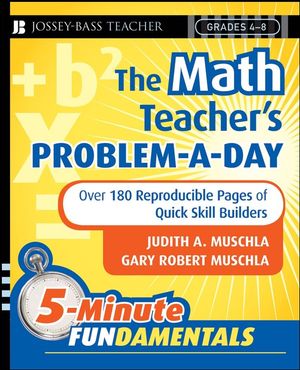The Math Teacher's Problem-a-Day, Grades 4-8: Over 180 Reproducible Pages of Quick Skill BuildersISBN: 978-0-7879-9764-9
Paperback
240 pages
April 2008, Jossey-Bass
 This is a Print-on-Demand title. It will be printed specifically to fill your order. Please allow an additional 10-15 days delivery time. The book is not returnable.
|
||||||
Acknowledgments.
The Authors.
How to Use This Resource.
Alignment with the Focal Points and Standards of the National Council of Teachers of Mathematics.
Section 1: Numbers and Operations.
1.1 Whole Number Place Value Through 100,000.
1.2 Whole Number Place Value Through 100 Millions.
1.3 Multiplication Facts.
1.4 Multiplication by One-Digit Numbers.
1.5 Multiplication by Two-Digit Numbers.
1.6 Multiplication of Multidigit Numbers, I.
1.7 Multiplication of Multidigit Numbers, II.
1.8 Estimation of Products.
1.9 Division Facts.
1.10 Divisibility Rules for 2, 5, and 10.
1.11 Divisibility Rules for 4 and 8.
1.12 Divisibility Rules for 3, 6, and 9.
1.13 Multiples and Least Common Multiples.
1.14 Factors and Greatest Common Factors.
1.15 Prime and Composite Numbers.
1.16 Prime Factorization.
1.17 Division by One-Digit Divisors.
1.18 Division by Two-Digit Divisors, I.
1.19 Division by Two-Digit Divisors, II.
1.20 Division by Two-Digit Divisors, III.
1.21 Estimation of Quotients.
1.22 Interpretation of Remainders.
1.23 The Mean.
1.24 Multiplication and Division with Money.
1.25 Reading and Writing Decimals.
1.26 Decimal Place Value Through Hundred-Thousandths.
1.27 Decimal Place Value Through Millionths.
1.28 Equivalent Decimals.
1.29 Comparing and Ordering Decimals.
1.30 Addition of Decimals.
1.31 Subtraction of Decimals.
1.32 Addition and Subtraction of Decimals.
1.33 Estimation of Decimal Sums and Differences.
1.34 Multiplication of Decimals by Powers of Ten.
1.35 Multiplication of Decimals, I.
1.36 Multiplication of Decimals, II.
1.37 Division of Decimals by Whole Numbers.
1.38 Division of Decimals by Decimals.
1.39 Division of Decimals by Decimals (with Zeroes as Placeholders).
1.40 Repeating Decimals.
1.41 Estimation of Decimal Products and Quotients.
1.42 Models of Equivalent Fractions.
1.43 Equivalent Fractions.
1.44 Simplifying Fractions.
1.45 Whole Numbers, Fractions, and Decimals on a Number Line.
1.46 Comparing and Ordering Fractions.
1.47 Addition and Subtraction of Fractions with Like Denominators.
1.48 Addition and Subtraction of Fractions with Unlike Denominators.
1.49 Fractions and Mixed Numbers.
1.50 Addition and Subtraction of Fractions and Mixed Numbers with Like Denominators.
1.51 Addition and Subtraction of Mixed Numbers with Unlike Denominators (with Regrouping), I.
1.52 Addition and Subtraction of Mixed Numbers with Unlike Denominators (with Regrouping), II.
1.53 Estimation of Fraction Sums and Differences.
1.54 Multiplication of Simple Fractions.
1.55 Multiplication of Fractions and Mixed Numbers.
1.56 Multiplication of Mixed Numbers.
1.57 Division of Simple Fractions.
1.58 Division of Fractions and Mixed Numbers.
1.59 Division of Mixed Numbers.
1.60 Estimation of Fraction Products and Quotients.
1.61 Expressing Fractions as Decimals.
1.62 Ratios.
1.63 Ratios and Proportions.
1.64 Percents.
1.65 Equivalent Fractions, Decimals, and Percents.
1.66 Percents of Numbers, I.
1.67 Percents of Numbers, II.
1.68 Finding Numbers When the Percent Is Known and Finding the Percent.
1.69 Discounts and Sale Prices.
1.70 Tips and Total Bills.
1.71 Sales Tax.
1.72 Simple and Compound Interest.
1.73 Percent of Increase and Decrease.
1.74 Exponents.
1.75 Scientifi c Notation.
1.76 Square Roots.
1.77 Positive and Negative Numbers.
1.78 Addition and Subtraction of Integers.
1.79 Multiplication and Division of Integers.
Section 2: Algebra.
2.1 Numeric Patterns.
2.2 Non-Numeric and Growing Patterns.
2.3 More Growing Patterns.
2.4 The Commutative and Associative Properties.
2.5 The Distributive Property.
2.6 Order of Operations, I.
2.7 Order of Operations, II.
2.8 Expressions.
2.9 Expressions and Equations, I.
2.10 Expressions and Equations, II.
2.11 Equivalent Expressions.
2.12 Properties of Equality.
2.13 The Relationship of Addition and Subtraction.
2.14 The Relationship of Multiplication and Division.
2.15 Writing and Solving Equations, I.
2.16 Writing and Solving Equations, II.
2.17 Writing and Solving Equations, III.
2.18 Inequalities.
2.19 Graphs of Simple Equations.
2.20 Proportional Relationships.
2.21 Inverse Proportional Relationships.
2.22 Linear Equations in Two Variables.
2.23 Slope of a Line, I.
2.24 Slope of a Line, II.
2.25 Slope of a Line, III.
2.26 Functions.
2.27 Quadratic Functions.
2.28 Exponential Functions.
2.29 Systems of Equations.
2.30 Arithmetic Sequences.
Section 3: Geometry.
3.1 Naming Two-Dimensional Shapes.
3.2 Regular Polygons.
3.3 Congruent Figures.
3.4 Similar Figures.
3.5 Lines of Symmetry.
3.6 Types of Triangles, Classifi ed by Sides.
3.7 Types of Triangles, Classifi ed by Angles.
3.8 Angles of a Triangle.
3.9 Angles in a Polygon.
3.10 Parallel Lines and Transversals.
3.11 Quadrilaterals, I.
3.12 Quadrilaterals, II.
3.13 Decomposing Polygons.
3.14 Tessellations, I.
3.15 Tessellations, II.
3.16 Glides and Refl ections.
3.17 Rotational Symmetry.
3.18 Similarity Statements.
3.19 Scale Factor.
3.20 Scale Drawings.
3.21 Similar Triangles.
3.22 Similar Triangles and Parallel Lines.
3.23 Slope Triangles.
3.24 Polyhedrons.
3.25 Relating Two-Dimensional Shapes to Three-Dimensional Prisms.
3.26 Relating Two-Dimensional Shapes to Three-Dimensional Pyramids.
3.27 Three-Dimensional Figures.
Section 4: Measurement.
4.1 Classifying and Measuring Angles, I.
4.2 Classifying and Measuring Angles, II.
4.3 Area of Rectangles and Squares, I.
4.4 Area of Rectangles and Squares, II.
4.5 Area of Triangles, I.
4.6 Area of Triangles, II.
4.7 Area of Parallelograms.
4.8 Area of Irregular Figures.
4.9 Surface Area of Prisms.
4.10 Volume of Prisms, I.
4.11 Volume of Prisms, II.
4.12 Circumference of Circles.
4.13 Area of Circles.
4.14 Circumference and Area of Circles.
4.15 Surface Area of Cylinders.
4.16 Volume of Cylinders.
4.17 Measurement in Linear Units.
4.18 Measurement of Weight and Capacity.
4.19 Measurement of Time.
4.20 Measurement of Temperature.
4.21 Area of a Sector.
4.22 The Pythagorean Theorem.
4.23 Distance Between Two Points on the Cartesian Plane.
4.24 Angles to Find Height and Distance.
Section 5: Data Analysis.
5.1 Frequency Tables.
5.2 Bar Graphs.
5.3 Double Bar Graphs.
5.4 Picture Graphs.
5.5 Line Plots.
5.6 Stem-and-Leaf Plots.
5.7 Line Graphs.
5.8 Line Graphs and Bar Graphs.
5.9 Ordered Pairs on a Coordinate Grid.
5.10 Histograms.
5.11 Circle Graphs.
5.12 Mean, Median, and Mode, I.
5.13 Mean, Median, and Mode, II.
5.14 Quartiles.
5.15 Box-and-Whisker Plots.
5.16 Scattergrams.
5.17 Lines of Best Fit.
5.18 Correlations and Lines of Best Fit.
5.19 Simple Probability.
5.20 Theoretical Probability and Predictions.
Answer Key.



